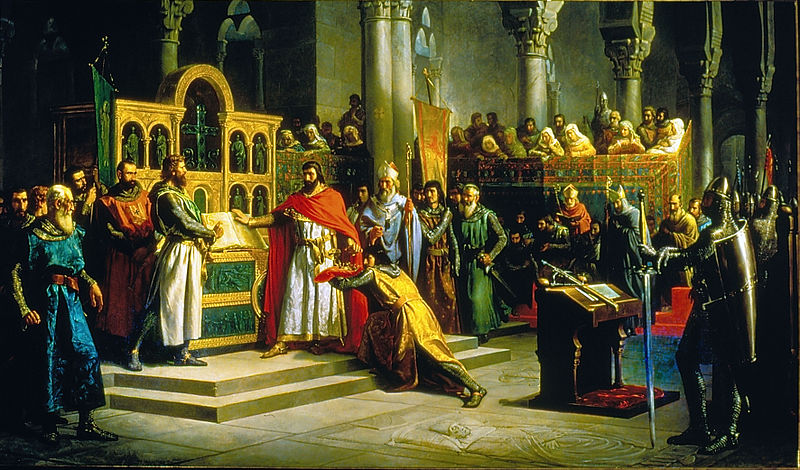 [E]ven Rodrigo’s heroism [Rodrigo Diaz de Vivar, known as el Cid] could not save King Sancho from the fate that awaited him at Zamora. On October 7, a knight named Vellido Adolfo snuck into Sancho’s camp and killed him with a lance. This treacherous act was an eerie repetition of the death that had met Ramiro I of Aragon nine years before, when as a young prince, Sancho had besieged the town of Graus.
[E]ven Rodrigo’s heroism [Rodrigo Diaz de Vivar, known as el Cid] could not save King Sancho from the fate that awaited him at Zamora. On October 7, a knight named Vellido Adolfo snuck into Sancho’s camp and killed him with a lance. This treacherous act was an eerie repetition of the death that had met Ramiro I of Aragon nine years before, when as a young prince, Sancho had besieged the town of Graus.
Alfonso quickly stepped into the vacuum created by his brother’s death, returning from Toledo to assume the title Alfonso VI of León-Castile. Having just proved that exile was no guarantee of security, Alfonso decided to make sure that his surviving brother, García, would pose no future threat. In 1073 Alfonso summoned García to the Castle of Luna in León and put him in chains, where the unfortunate man languished for 17 years, until his death in 1090.
The king’s ferocity did not extend to his brother’s armiger. According to the medieval code, a vassal could never be blamed for faithfully serving his lord. Indeed, the feats of arms Rodrigo had performed against Alfonso’s men made him all the more valuable to the new regime. Alfonso therefore wasted no time in securing Rodrigo’s services.

Painting by Marcos Giráldez de Acosta. Alfonso VI, king of Castile and Leon, swearing in the church of Santa Gadea de Burgos, before Rodrigo Diaz de Vivar.
According to a tradition accepted by Menéndez Pidal, Rodrigo was not so eagerly swayed. He and the rest of Sancho’s vassals were convinced that Alfonso had engineered the treacherous murder of their king. Before he would give his allegiance to Alfonso, Rodrigo insisted that the king swear an oath, in the Church of Saint Gadea in Burgos, that he had not murdered his brother. After Alfonso repeated the oath three times, Rodrigo replied, “Then, if you swear falsely, may it please God, that a vassal slay you, even as the traitor Vellido Adolfo slew King Sancho.”
Philip Koslow, El Cid (New York: Chelsea House Publishers, 1993), 62-4.
Short Stories on Honor, Chivalry, and the World of Nobility—no. 336









